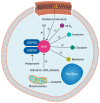Novel Insights into Psychosis and Antipsychotic Interventions: From Managing Symptoms to Improving Outcomes
- PMID: 38892092
- PMCID: PMC11173215
- DOI: 10.3390/ijms25115904
Novel Insights into Psychosis and Antipsychotic Interventions: From Managing Symptoms to Improving Outcomes
Abstract
For the past 70 years, the dopamine hypothesis has been the key working model in schizophrenia. This has contributed to the development of numerous inhibitors of dopaminergic signaling and antipsychotic drugs, which led to rapid symptom resolution but only marginal outcome improvement. Over the past decades, there has been limited research on the quantifiable pathological changes in schizophrenia, including premature cellular/neuronal senescence, brain volume loss, the attenuation of gamma oscillations in electroencephalograms, and the oxidation of lipids in the plasma and mitochondrial membranes. We surmise that the aberrant activation of the aryl hydrocarbon receptor by toxins derived from gut microbes or the environment drives premature cellular and neuronal senescence, a hallmark of schizophrenia. Early brain aging promotes secondary changes, including the impairment and loss of mitochondria, gray matter depletion, decreased gamma oscillations, and a compensatory metabolic shift to lactate and lactylation. The aim of this narrative review is twofold: (1) to summarize what is known about premature cellular/neuronal senescence in schizophrenia or schizophrenia-like disorders, and (2) to discuss novel strategies for improving long-term outcomes in severe mental illness with natural senotherapeutics, membrane lipid replacement, mitochondrial transplantation, microbial phenazines, novel antioxidant phenothiazines, inhibitors of glycogen synthase kinase-3 beta, and aryl hydrocarbon receptor antagonists.
Keywords: antipsychotic drugs; aryl hydrocarbon receptor; dopamine; naturally occurring antipsychotics; senotherapeutics.
Conflict of interest statement
The authors declare no conflicts of interest. Where authors are identified as personnel of the International Agency for Research on Cancer/WHO, the authors alone are responsible for the views expressed in this article and they do not necessarily represent the decisions, policy or views of the International Agency for Research on Cancer/WHO.
Figures







Similar articles
-
Mechanisms underlying psychosis and antipsychotic treatment response in schizophrenia: insights from PET and SPECT imaging.Curr Pharm Des. 2009;15(22):2550-9. doi: 10.2174/138161209788957528. Curr Pharm Des. 2009. PMID: 19689327 Free PMC article. Review.
-
Does fast dissociation from the dopamine d(2) receptor explain the action of atypical antipsychotics?: A new hypothesis.Am J Psychiatry. 2001 Mar;158(3):360-9. doi: 10.1176/appi.ajp.158.3.360. Am J Psychiatry. 2001. PMID: 11229973 Review.
-
Cytokines and Madness: A Unifying Hypothesis of Schizophrenia Involving Interleukin-22.Int J Mol Sci. 2024 Nov 11;25(22):12110. doi: 10.3390/ijms252212110. Int J Mol Sci. 2024. PMID: 39596179 Free PMC article. Review.
-
Frontal fasciculi and psychotic symptoms in antipsychotic-naive patients with schizophrenia before and after 6 weeks of selective dopamine D2/3 receptor blockade.J Psychiatry Neurosci. 2016 Mar;41(2):133-41. doi: 10.1503/jpn.150030. J Psychiatry Neurosci. 2016. PMID: 26599135 Free PMC article.
-
Antipsychotic drugs: evolving mechanisms of action with improved therapeutic benefits.Curr Drug Targets CNS Neurol Disord. 2004 Jun;3(3):217-25. doi: 10.2174/1568007043337373. Curr Drug Targets CNS Neurol Disord. 2004. PMID: 15180482 Review.
Cited by
-
Lactylation in CNS disorders: mechanisms, cellular function, and disease relevance.Front Cell Dev Biol. 2025 Mar 28;13:1566921. doi: 10.3389/fcell.2025.1566921. eCollection 2025. Front Cell Dev Biol. 2025. PMID: 40226593 Free PMC article. Review.
-
Plasma and Serum LC-MS Lipidomic Fingerprints of Bipolar Disorder and Schizophrenia.Int J Mol Sci. 2025 Jun 26;26(13):6134. doi: 10.3390/ijms26136134. Int J Mol Sci. 2025. PMID: 40649910 Free PMC article. Review.
-
An in-depth exploration of the association between olanzapine, quetiapine and acute pancreatitis based on real-world datasets and network toxicology analysis.Front Pharmacol. 2025 May 2;16:1529416. doi: 10.3389/fphar.2025.1529416. eCollection 2025. Front Pharmacol. 2025. PMID: 40385473 Free PMC article.
References
Publication types
MeSH terms
Substances
Grants and funding
LinkOut - more resources
Full Text Sources
Medical
Miscellaneous

